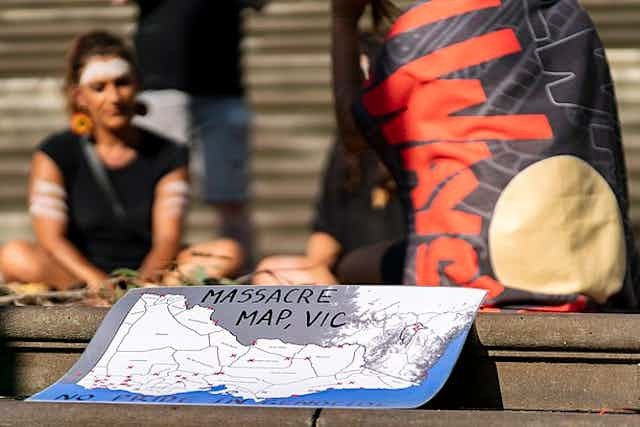This article mentions ongoing colonial violence towards Aboriginal and Torres Strait Islander people, and contains references that feature antiquated language.
Truth-telling is a key demand in the Uluru Statement and is seen as a vital step for both the Voice to Parliament and a Treaty. However, there has been ongoing debate as to whether historical injustices against First Nations peoples need to be addressed today.
Wiradjuri and Wailwan lawyer Teela Reid posed a question in a 2020 essay, is Australia ready to Gari Yala (speak truth) and reckon with its past?
We recently conducted a study to investigate this question by looking at First Nations community truth-telling practices. Our study found these communities have shown significant leadership in truth-telling, often without resources or support. Importantly, they have invited non-Indigenous people to also take part in truth-telling.
Truth-telling can take the form of memorial and commemorative events, repatriation of remains and cultural artefacts, the renaming of places, and the creation of public artworks and healing sites. A recent example is the Yoorrook Justice Commission’s truth-telling commission. Yoorrook released the truth-telling report this week, providing 46 recommendations for reforms into Victoria’s justice and child protection systems.
We found when non-Indigenous people participated in truth-telling with First Nations communities, it helped build a deeper shared understanding of the past and the achievements of First Nations peoples. This is why truth-telling is a collective social responsibility and non-Indigenous Australians are crucial participants.
But there is still much work to do. Many important historical events and First Nations achievements remain largely unrecognised. Sustained funding and support and the recognition of Australia’s difficult historical truths are crucial.
Our research findings
Our research focused on documenting community truth-telling that reclaimed First Nations sovereignty and self-determination, as well as recognising colonial violence. We did in-depth investigations through 25 case studies, including ten in which we held yarning interviews with community organisers. These interviews helped shed new light on rich and diverse ways to engage with the truths of colonial history.
In the MacArthur region of New South Wales, reconciliation group Winga Myamly worked to make sure the 1816 Appin massacre on Dharawal Country is recognised and commemorated annually.
In the massacre, at least 14 (likely more) Aboriginal men, women and children were killed by members of a British Army regiment. The regiment chased the group to nearby cliffs at Cataract Gorge where many jumped to their deaths.
The 2019 commemoration brought together Dharawal Elder Aunty Glenda Chalker, a descendent of Giribunger, one of the survivors of the massacre, and Sandy Hamilton, descended from Stephen Partridge, who served with the regiment that carried out the attack.
In Portland, Victoria, a towering gum leaf sculpture, Mayapa Weeyn (meaning “make fire”) was erected near the site of the Convincing Ground massacre. This is where between 20 and 200 members of the Kilcarer Gunditj clan were killed by British whalers.
The sculpture recognises all 59 Gunditjmara clans, many of whom were killed during the Eumeralla Wars that followed the Convincing Ground massacre. Gunditjmara Elder Walter Saunders, who designed the sculpture, spent two years building it and talking with local residents in an informal process of truth-telling.
In Tasmania, the Mannalargenna Day Festival commemorates Pairrebeenne/Trawlwoolway leader Mannalargenna. Mannalargenna tried to negotiate to save the lives of Aboriginal people in Tasmania who had been devastated by the Black War during the 1830s.
Our study found truth-telling is more effective when it occurs through immersive experiences. Aboriginal and Torres Strait Islander cultural practices, such as smoking ceremonies, walking on Country, storytelling and personal engagements with survivors, contributed to healing, dialogue and a deeper shared understanding of history.
Through these events Indigenous people deepened their connections to community, history and Country and non-Indigenous people learned about these connections from them. The increasing attendance at events such as the Appin massacre memorial, the Mannalargenna Day Festival and similar commemorations is evidence of the impact of this type of truth-telling.
Why is truth-telling important?
Aboriginal and Torres Strait Islander peoples have long called for Australia’s history to be told truthfully. The local truth-telling activities we have documented are examples of how communities have responded to this desire. They emphasise the importance of supporting communities to tell their stories, rather than government directing how truth-telling occurs.
While truth-telling does not guarantee reconciliation, the participants in our study stressed that meaningful reconciliation cannot occur without it. They emphasised the importance of reconciliation between First Nations and non-Indigenous communities because for some people these relationships have never existed, or are in need of repair.
Truth-telling is also crucial for political and social transformation. For example, the Queensland government is using truth-telling to help inform the path to Treaty. In Victoria, the Yoorrook Justice Commission is investigating historic and ongoing injustices experienced by First Nations peoples, alongside ongoing Treaty negotiations.

Read more: What is NAIDOC week? How did it start and what does it celebrate?
Community truth-telling can demonstrate the power of Indigenous identity and self-determination. It can also counter past attempts to erase Aboriginal and Torres Strait Islander peoples from Australian history.
Truth-telling highlights the crucial roles and contributions of First Nations peoples. Their acts of bravery and sacrifice, resistance against colonialism and contributions to communities.
Although some local governments have played a key role in supporting truth-telling, more support for local initiatives is required. National proposals, such as a national recognition of Mabo Day and a formal remembrance for frontier conflicts, have the potential to create a better environment for truth-telling.

